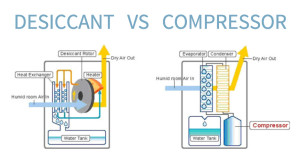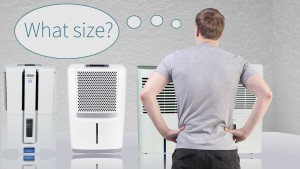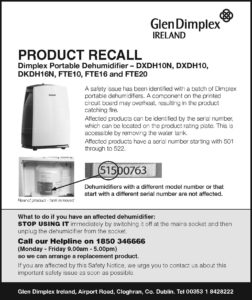 Dehumidifiers are great appliances for bringing down relative humidity levels so that healthier living conditions can be achieved.
Dehumidifiers are great appliances for bringing down relative humidity levels so that healthier living conditions can be achieved.
Mould thrives in humidity levels above 65% and can cause not only respiratory problems or other signs of illness such as fatigue, skin rash and weepy eyes but it can damage your property and furnishings as well.
Domestic dehumidifiers can be used in homes where they are often turned on and off by hand when needed and the water tank is also often emptied manually.
Automated dehumidifiers which feature advanced energy-saving technology and continuous drainage facilities are often employed in mobile homes and caravans especially when these units are empty over the winter.
Are Dehumidifiers A Fire Risk
Dehumidifiers are appliances just like fridges, freezers and washing machines and fire risk does exist however the risk is very minimal.
There are two types of fire risk issues when is comes to dehumidifiers
- Manufacturer issues
- End user issues
Manufacturer Fire Risk Issues
Manufacturer fire risk issues mainly occur due to wiring or other construction issues. These type of issues are rare and when the manufacturer discovers them the company immediately issues a dehumidifier recall of the affected dehumidifier model.
In the UK and Ireland it only has been household appliance company Glen Dimplex which has recalled several Dimplex dehumidifier models over the last few years.
End User Fire Risk Issues
End user fire risk issues fall under two headings
- Poor maintenance
- Improper use
Maintaining a dehumidifier is very easy and takes minimal time.
The other issue of improper use is an educational issue and at ByeMould we are addressing this very issue.
Before we look at maintenance and improper use issues you need to know how a dehumidifier works.
How Does A Dehumidifier Work 
The most common type of dehumidifier with fire risk is the compressor type.
Once you turn a compressor dehumidifier on the internal fan will start to draw room air into the vent through the filter.
The filtered air then passes through a cold coil and condenses. The resulting moisture falls down into the water bucket or into the continuous drainage hose while the left over semi-dry air is passed through a hot coil.
The cool air is warmed up in the hot coil and released back into the room via the exit grill.
This process repeats over and over until the set room humidity level is reached.
It is the compressor which cools the cold coil hence the name compressor dehumidifier.
Dehumidifier Technology To Prevent Fire Risk
Compressor dehumidifiers contain a feature called Auto Defrost that stops the dehumidifier from operating when the temperature gets too cold.
When the cooling coil of a compressor dehumidifier gets too cold it can’t extract any moisture from the air. Once this occurs auto defrost stops the unit from operating until the coil warms up a little and sufficient moisture extraction is possible.
If there was no auto defrost feature the dehumidifier would just keep on running while not extracting any moisture which could possibly lead the dehumidifier to overheat.
Also if the dehumidifier were to keep operating with frozen coils then those coils would have a much shorter life span. When buying a compressor dehumidifier make sure that it contains the Auto Defrost feature.
We contacted Inventor dehumidifiers to see how their dehumidifiers are designed to prevent fires.
“Inventor dehumidifiers have been designed to ensure the appropriate and necessary safety during their operation. They include a non-flammable refrigerant (R134a and R410a) with substances of low global warming potentials and their compressor is equipped with a thermal protection, so that the device will shut off automatically in case of abnormal operation. Inventor dehumidifiers provide advanced safeguards to prevent the unit’s malfunctions and stop immediately their operation, such as overflow protection, auto defrost system, overheating protection, refrigerant leakage detection and sensor errors (temperature and humidity).”
 Improper Dehumidifier Use
Improper Dehumidifier Use
Airflow
The main fire risk through improper dehumidifier use is that people use dehumidifiers in areas that are too small for the dehumidifier.
In order to avoid overheating dehumidifiers need a certain amount of airflow around them as a lack of airflow could cause overheating.
You might find this guide helpful if you want to know how to use a dehumidifier to dry a room.
Blocking The Grills
Make sure that you never place clothes or anything else on top of the dehumidifier when the unit is in operation as this will also impede airflow.
Never place laundry on top of the dehumidifier to dry it. When drying laundry use a clothes horse and situate the washing at least a foot away from the dehumidifier. Ensure that no water droplets will come into contact with the dehumidifier.
Dehumidifier Maintenance
Like any appliance or machine the better you look after it the better it will look after you.
Dehumidifiers are not hard to maintain and here are a few things that you can do.
Clean or Replace Filter
Ensure that you clean your filter every few weeks or once a month depending on how much you use the dehumidifier. The less dirt that clings to the filter the more efficient your machine becomes. If the dehumidifier really has to suck hard to get air into it then you could risk overheating the unit.
Anti-bacterial filters should only be lightly vacuumed not washed so make sure that you know which filter you have.
If the filter shows signs of wear or tear either on the fabric or plastic sides then it should be replaced. Contact the dehumidifier manufacturer for more information.
Vacuum Grills
While you are giving the filter a quick hoover just run the hoover over the air intake and outlet grills as this will also make your dehumidifier more efficient.
Tighten Screws
Once per year you should remove the outer casing of the dehumidifier and tighten the fan shaft screws. If these screws come loose the fan can separate from the shaft causing major damage.
Clean Fan Blades
Simply wipe the fan blades with a moist cloth to remove any collected dirt and dust.
Clean The Coils
When the outer casing has been removed you should also clean the coils. Simply brush them with a small soft brush.
The coil is where water extraction occurs and dirt can cause water to freeze on the coils making them less effective than clean coils.
Get A Dehumidifier Service
If you don’t want to do any of the above jobs yourself you can always get your dehumidifier serviced.
The bonus of getting your dehumidifier serviced is that the motor will get a good service as well.
Desiccant Dehumidifiers 
Although we have focused on compressor dehumidifiers in this articles the same rules of airflow apply to desiccant dehumidifiers.
Desiccant dehumidifiers don’t have coils for extraction (they use silica) but they do have air grills which to have sufficient airflow and the parts also need to be kept clean.
Automated Dehumidifiers
The adage ‘what you pay is what you get’ certainly rings true here.
Lower cost dehumidifiers are known as manual dehumidifiers as the users themselves have to change the settings manually. Of course if you leave a dehumidifier running on full power for too long then the unit heats up which could potentially lead to fire risk.
Automated dehumidifiers are dehumidifiers which change settings automatically once certain humidity levels have been reached.
The Meaco DD8L dehumidifier range feature what Meaco calls Control Logic energy-saving technology.
What happens is that if you set the dehumidifier to reach 50% humidity for example the unit will work until the humidity level reaches 50%. Once the room humidity hits 50% the dehumidifier goes into ‘sleep’ mode for half an hour.
After half an hour the dehumidifier will wake up for 5 minutes to sense the new humidity level in the air.
If the humidity level has stayed at 50% or below then the dehumidifier will go back into ‘sleep’ mode for another half an hour before testing the air again for another 5 minutes.
If the humidity level has risen above 50% in the interim then the dehumidifier will switch into the most energy-efficient mode possible to bring down the humidity back to the target level.
It’s easy to see that with limited operating time there is no change of overheating.
Check The Recall List
If you already own a dehumidifier or are thinking of purchasing one second-hand then you would be advised to check on the electrical safety first website to ensure that your particular model has not been recalled.
Another tip is to place the word ‘dehumidifier recall’ into your favourite online news site so that when dehumidifier news is released you’ll be notified. This way when a recall has been issued you will be notified.
Conclusion
Dehumidifier fires in the UK are very rare as most dehumidifiers are manufactured by smaller companies who keep a very close eye on manufacturing standards.
It’s interesting to hear that most dehumidifier recalls are made by larger companies such as Glen Dimplex in the UK and Midea in the US.
Perhaps due to the amount of dehumidifiers and other products being manufactured quality control is a little looser than that by smaller companies who really can’t afford any business mistakes as otherwise they would be wiped out.
If you look after your dehumidifier as described above then you should have no concern about dehumidifier fire risk and as such you can use them in homes, mobile homes, caravans, garages and sheds etc.
Is there anything else that we should have covered in this dehumidifier fire risk article? Let us know in the comments below.
